

This 1950′s, nearly 1
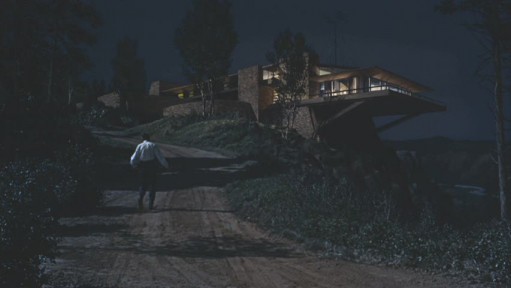
The Vandamm House:
They
needed to come up with a reason why all of the characters would be
congregating at Mt. Rushmore, so Lehman decided that the bad guys would
have their headquarters nearby. It’s known as “The Vandamm House” after
James Mason’s character, Phillip Vandamm.
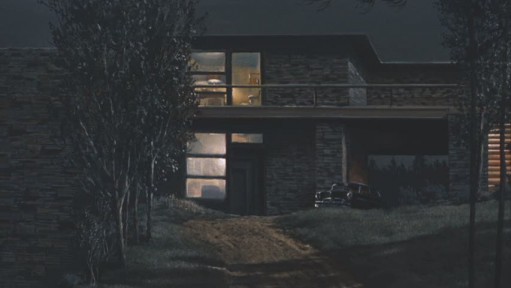
A lot of people have asked me whether it’s a real house, and if it’s really on top of Mt. Rushmore. Sadly, no, it’s not real. The exterior was a matte painting (a pre-digital effect when a real set or location was combined with a painting), and the interior was created on a soundstage.
In reality, there is no way anything could be built on top of the monument, even temporarily for a film.

According to a fascinating post on Jetset Modern, Hitchcock knew he wanted it to be a Modernist house. In the late ’50s, Frank Lloyd Wright was the most famous Modernist architect in the world. Any house he designed for the film would have been instantly recognizable to audiences.
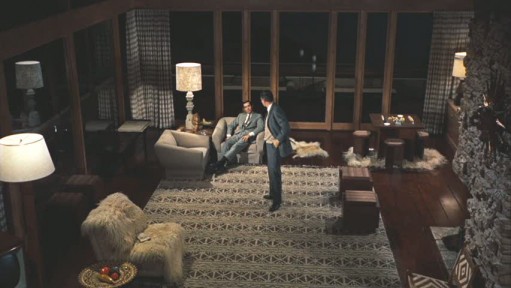
The problem: they couldn’t afford Wright’s fee. So Hitchcock decided they’d just build a house that looked like one Wright would have designed.

The second problem: the top of Mt. Rushmore was too fragile to build anything on it. The MGM researchers had to get special permits and Park Service escorts just to visit the area in order to photograph and measure it.

According to Sandy McLendon of Jetset Modern:
The house would be created entirely in
Culver City, where MGM was located. It would consist of a few sections
built at full-scale, as movie sets. The exterior shots would depend on
special effects. Certain shots would blend the sets together with the
special effects, to create the illusion that the house was real. The
final design was of a hilltop house of limestone dressed and laid in the
manner made famous by Wright, along with a concrete cantilever under
the living room area.

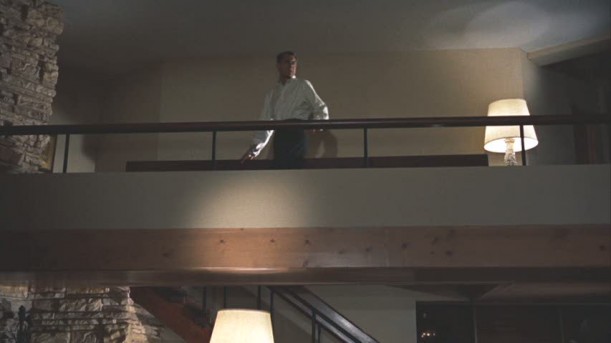
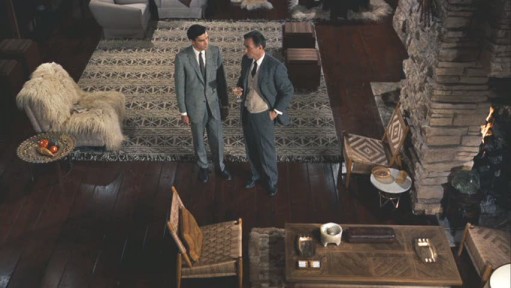
Just when he thinks he’s in the clear, Vandamm’s housekeeper pulls a gun on Thornhill:
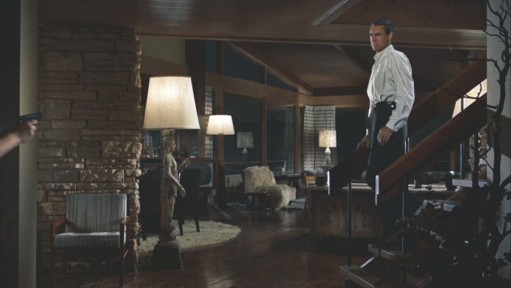
McLendon explains how the set was designed:
Certain areas like the outside of the
bedroom wing had their exteriors finished, so that they could be shot
from inside looking out, or outside looking in.
The interiors were masterpieces of
deception: nearly nothing was what it appeared. The limestone walls were
mostly plaster, real limestone was used in a few places where the
camera would be very close. The expanses of window were mostly without
glass; glass reflects camera crews and lights.

All of the scenes involving the Vandamm house were shot at night so that the effects would look more realistic. Read more about it and see examples of how the matte photography technique worked here. (Thanks to Lyle for the info!)
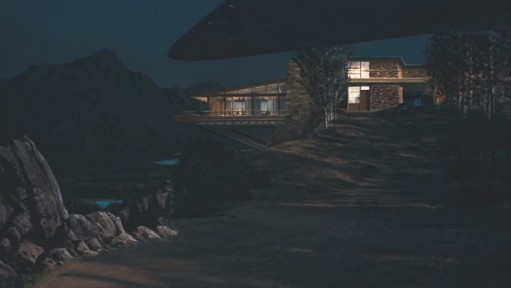
More North by Northwest Movie Trivia:
- North by Northwest was just the working title, but they never came up with anything better. One they considered: The Man in Lincoln’s Nose. (Seriously.)
- Jimmy Stewart was originally considered for the role of Thornhill, but Hitchcock decided he looked “too old.” Cary Grant was 55 when he filmed it–4 years older than Stewart–but looked younger.
- MGM wanted Cyd Charisse in the role of Eve Kendall, but Hitchcock insisted on Eva Marie Saint.
- MGM designed an entire wardrobe for Saint’s character, but Hitchcock threw out almost everything. She says he took her to Bergdorf-Goodman and selected clothes for her “right off the models.”
- Hitchcock gave Saint three basic directions: 1) Lower your voice. 2) Don’t use your hands. 3) Always look directly into Cary Grant’s eyes.
- North by Northwest was nominated for 5 Oscars but lost in every category.
The movie trailer, humorously presented by Alfred Hitchcock himself:
What’s your favorite Hitchcock movie? I just watched Rebecca again last week (you can see my post about Manderley here). Hitchcock knew how to work a great house into a suspenseful movie!
http://hookedonhouses.net/2010/03/15/north-by-northwest-hitchcocks-house-on-mt-rushmore/
b
Just saw "North By Northwest" for the first time and was captivated by the Vandamm house in the film. Hoping it was a real landmark building that I could one day visit, I did a quick search. Jetset magazine answered the question for me: it's not real. Impressive work, nonetheless.
http://www.flickr.com/groups/mid-century/discuss/72157594261231182/
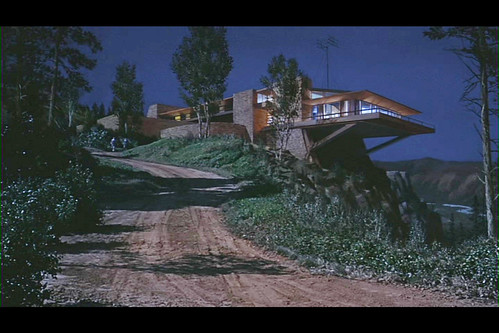

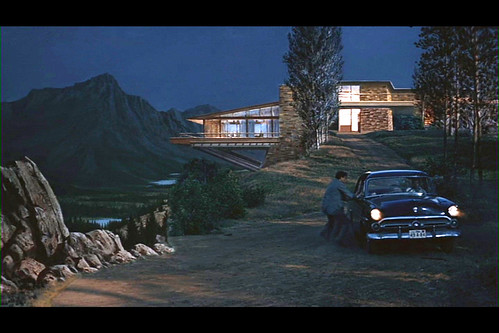
The meat of the Jetset article by Sandy McLendon is below:
b
Just saw "North By Northwest" for the first time and was captivated by the Vandamm house in the film. Hoping it was a real landmark building that I could one day visit, I did a quick search. Jetset magazine answered the question for me: it's not real. Impressive work, nonetheless.
http://www.flickr.com/groups/mid-century/discuss/72157594261231182/



The meat of the Jetset article by Sandy McLendon is below:
The set designers on "North by Northwest" were Robert Boyle, William A. Horning, Merrill Pye, Henry Grace, and Frank McKelvey. It has not been possible to sort out exactly which of these men was responsible for the house design, but whoever did it did his homework. The final design was of a hilltop house of limestone dressed and laid in the manner made famous by Wright, along with a concrete cantilever under the living room area. The house was correctly situated just under the top of its hill; Wright was famous for saying, "of the hill, not on top of the hill." The house’s massing- heavy with limestone in the rear where the house met the hillside, light with glass and concrete at the free end of the cantilever- was also correctly Wrightian. To the knowing, the design contained one element that would not have been used by Wright; there were steel beams supporting the cantilever. Wright would almost certainly have come up with an unsupported cantilever, as he did at "Fallingwater", but very few viewers would know that. It is also possible that the mass audience requirements for "North by Northwest" dictated the use of the beams; Hitchcock may have felt that a true Wright cantilever would distract audiences from the plot, making them wonder what on earth was holding the house up, instead of focusing on the action. In the event, the beams also served the plot by giving Cary Grant a way to climb into the house.
The portions of the house that were actually built were the living room, part of the bedroom wing, the carport, and a bit of hillside under the living room where the cantilever beams were. Most of the construction was of interiors only, but certain areas like the outside of the bedroom wing had their exteriors finished, so that they could be shot from inside looking out, or outside looking in. The interiors were masterpieces of deception: nearly nothing was what it appeared. The limestone walls were mostly plaster, real limestone was used in a few places where the camera would be very close. The expanses of window were mostly without glass; glass reflects camera crews and lights. For a few shots where reflections were needed, and could be controlled, glass was used in some places. And in the best tradition of movie-set building, some of the walls were "breakaways"- walls that looked perfectly real and solid, but were capable of being unbolted and taken away to accommodate the bulky VistaVision ® cameras used in 1958. An enormous black velvet cyclorama surrounded the sets, to give the illusion of a deep South Dakota night. All the house sequences were deliberately done as nighttime ones, because the special effects needed to create the house’s exteriors would be best concealed that way.
The luxurious Modernism of the house extended to its furnishings.
The living room set was dressed in the best of 1958’s furniture and art, and it makes a very interesting point. The furniture is largely Scandinavian Modern. There is Chinese art, and a Pre-Colombian statue figures prominently in the action. Greek flokati rugs are on the floors. Vandamm’s spying is meant to set the nations of the world at war, but it seems they co-exist peacefully enough under his roof!
The exterior sequences were done using a pre-digital technique called ‘matting’. In matte photography, a real location or set is combined with a painting; the real portion is then made to appear part of a larger area that does not actually exist. A very famous example is when Dorothy and her friends run toward the Emerald City in "The Wizard of Oz". The foreground with the actors and the deadly field of poppies is a set; the background is a painting. (See the sidebar article below for pictures and a simplified explanation of matting.)
And there it is- the truth about the Vandamm House. It’s not real, and it never was. It’s imagination and technology and our dreams, all wrapped up together. It’s exactly where we wanted a Hitchcock villain to live. And if it never existed in Rapid City, South Dakota, it is real where it counts- in the minds of the millions who have seen it, and loved it, and coveted it for their own.


Δεν υπάρχουν σχόλια:
Δημοσίευση σχολίου